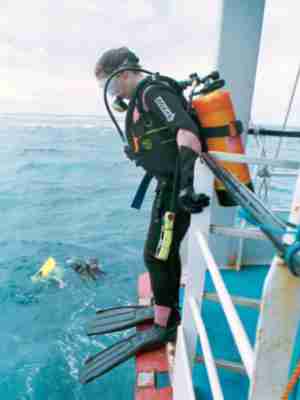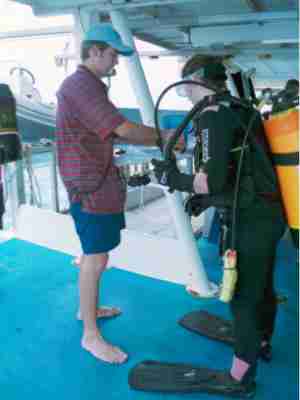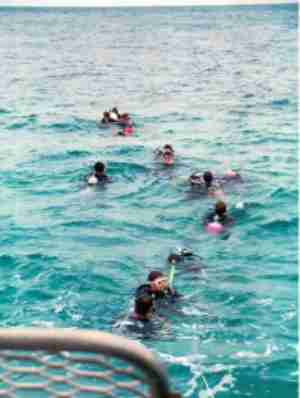ADVANCED DIVING TECHNIQUES
SKILLS IN THE MAKING
By Andrew Whitehead
Published in Dive Log Australasia March 2002
It seems to be common practice in the industry to package four or five specialty courses, and present them as an “Advanced Open Water Diver” course. It makes a lot of sense to do this because there are economies of scale for the dive shop and convenience for the diver.
Therefore, it is possible to construct a course which reinforces the basic open water skills and covers the additional skills and safety procedures that are needed for enjoyable boat diving. If you think through the steps in a dive, there are many little skills involved: dive planning, buddy procedure, entry, controlled descent, instrument checks, dive computer use, navigation, returning to the anchor, controlled ascent, safety stops, retrieval, exit, safety log, stowing gear, refilling tanks. When you combine this learning with a trip on a liveaboard, you have the ingredients for a great weekend’s diving.
Classroom
Neil Harris from Absolute Scuba in Brisbane has designed such a course to advance his divers to a higher level. The course is presented as “advanced diving techniques” and covers the following subjects:
- Navigation
- Computer Use & Benefits
- Waves Tides & Currents
- Boat Diving
These subjects are included to improve skills, provide an understanding of safe diving, and some knowledge of the local environment. There are no written exams. Competency is measured when the divers demonstrate their new skills during the dives.
Dive Computer
At the “SAFER LIMITS 2000”, Hyperbaric Workshop, held at the Wesley Hospital, Brisbane, September 2000, it became clear that diving is considered to be a relatively safe recreation these days when compared with other activities. This opinion was based on the number of DCI cases treated in Australia compared with the total number of dives per year. One of the main reasons for this is that most divers now use a dive computer, rather than tables or nothing at all. It would seem that there is evidence to suggest that the use of the dive computer has made diving safer.
The dive computer has become as much an integral part of scuba diving as the buoyancy compensator. In the Advanced Diving Techniques course, time is given to identifying and explaining the built-in functionality of each diver’s computer so that they can make full use of its capabilities. As with all these electronic gadgets, there is a considerable difference in price, features and functionality between a basic dive computer and, for example, an air-integrated Nitrox computer.
There is no other special gear requirement for this course apart from the “Safety Sausage” which is mandatory for diving in Queensland. The students are encouraged to buy or borrow a small reel which is used to deploy the sausage during safety stops.
The Vessel
On Friday night, we met at Newport Waterways, Scarborough, and loaded our gear, and two “G cylinders” of oxygen, on board “Big Cat Reality”. This is a 25 metre, luxury liveaboard vessel with facilities to accommodate up to 24 divers and 7 crew including a K180 dive compressor, and a rescue vessel. The ship has the latest navigation equipment with a professional and experienced crew. Big Cat Reality has a 10 metre beam which provides a large stable dive platform.
On this trip our group, including students and us pleasure divers, occupied ‘port side’ and a group from another shop were on ‘starboard side’. Many of us had been on trips together before and there was much camaraderie between the groups of divers. We were welcomed aboard by Skipper James McVeigh and made to feel very much at home.

On this vessel there are two sets of back-to-back seats with numbered tank racks, and room for big dive bins underneath.
The first thing for the novice boat diver to learn is that you set up your gear in one of these racks and this becomes your allotted number for the duration of the trip. You then write your name, rack number, diving qualifications, and whether you are using a computer, on the Safety Log prior to each dive.
The Dives
We crossed Moreton Bay on Friday night and anchored in a sheltered bay on the west coast of Moreton Island. At first light, we headed out to Flinders Reef, about 5 kilometres north of Cape Moreton.
The next lesson for the novice boat diver is to listen to the dive briefing, put on your gear, retrieve your fins, and clip on the optional torch. You then walk around to the starboard side, put on our fins and wait to be checked off by the dive master. Your tank pressure is duly noted and the dive master clips your tag onto a convenient D-ring on your BCD.
Then hang on to your mask, torch, regulator, etc, take a giant stride over the side, give the OK signal and follow the current line to the bow.
The Pinnacle
“The Pinnacle” is a coral ridge just south of the exposed Flinders Reef. My buddy and I descended the anchor chain and headed over to a shallow, clear area to sort ourselves out. Neil Harris arrived with his students and set off on some natural navigation exercises. We went in the opposite direction around the ridge and into a rugged valley at 20 metres. There was a large crayfish in a hole and a number of good-sized territorial fish about.
Back on board, the dive master unclips your tag and notes your bottom time, maximum depth and remaining air pressure. When your hands are dry, you must sign the safety log beside your name. This paperwork is required in order to comply with Queensland’s Workplace Health & Safety diving industry code of practice.
Once their gear is stowed, all the students had to do was remove their first stage from the tank valve and their cylinder would be re-filled with air. However, most of the pleasure divers from Absolute Scuba were using Nitrox mixes. Under Neil’s careful supervision, we calculated the correct amount of pure oxygen to put in our 100 cu ft tanks, so that it would end up with the required mix when topped up with air. When each tank was full, the diver analysed the mix, filled in the tag and the log sheet with the pressure, gas mix and maximum operating depth.
Flinders Reef
Unlike the other reefs off Moreton and Stradbroke Islands, Flinders Reef is covered in a variety of hard and soft corals. It is classified as a “Protection Zone” which extends 50 metres seaward from the exposed reef. Boating and diving are allowed in this zone but no fishing. The recent introduction of permanent moorings is a welcome addition to protect the coral from boat anchors and chain.
Skipper James moved Big Cat Reality into the lee of the exposed reef where there were some smaller charter boats. Three more dives were conducted during the day on this beautiful coral reef at around 14 metres. This gave the students much practice in dive planning, buddy procedure, entry, controlled descent, instrument checks, dive computer use, navigation, returning to the anchor, controlled ascent, and safety stops. They gained some experience at landing on the big rear stairs in the choppy conditions and hauling themselves out of the water. Neil also took them on a little underwater orienteering exercise!
Night Dive
Only qualified night divers and those doing the Night Diver Specialty course went on the superb night dive. Three of us spent 45 minutes practically under the boat in the 23-deg Celsius water. There was a big ledge with a large green turtle, a big wobbegong, and several crayfish scuttling around. As I approached the stern holding up my torch, a large wave crashed past the steps. The dive master got the torch and nearly went in with it! The white water created zero visibility while I waited for my next chance to exit. Handing over fins and weight pouches was out of the question. Just land on your knees and get aboard as quick as you can!
We headed in to the sheltered anchorage at Cowan where the crew prepared a barbeque for us. During dinner, we watched Neil’s new promotional video for MV Princess II featuring beautiful underwater footage from Fiji. This was followed by the very popular movie, “Gladiator”.
Next morning, Skipper James had a conference with the three dive masters and made a plan for the day. When conditions are rough in the open ocean, we dive on the inside of Moreton Island at sites called Comboyuro Drop Off, The Pines, Curtin Artificial Reef and Tangalooma Wrecks. The mid-morning high tide would be ideal for Curtin Artificial Reef, giving time for two dives at The Pines on either side of the high tide. We anchored off Bulwer for a drift dive in the incoming tide.
Drift Dives
The preparations for the drift dive were another new experience for the students. The divers held on to the surface current line or Trail Line, then descended together and drifted along the wall.
I took some photos, then headed inside for a hot shower, a shave, and some clean clothes. These are the luxuries of liveaboard diving! According to Neil, there are three rock walls, each a little further out than the other. A wonderful exercise in natural navigation! The students with reels practiced sending their safety sausages to the surface to indicate their position and enable them to stay at the 5-metre level. After completing a drifting safety stop, Big Cat Reality was right there to pick them up.
Wreck Dive
We moved south to Curtin Artificial Reef for a dive at high tide. I decided to use my big 15 litre (120 cu ft) tank for this dive. Neil decanted some pure oxygen and topped it up with air, which analysed as a 33% Nitrox mix. We descended the anchor chain to the stern of the old tug Melbourne in a very slight current. Neil showed his students how to navigate from wreck to wreck using their little URGQ Charts. We swam down the deck of the Melbourne, then to Barge 25, then explored the gravel barge Estrella Del Mar, the tug Loevenstein, and across to the Etmore at 22 metres.
By this time the tide had reached its peak so there was good visibility and no current. People gave the half-tank signal and Neil led us back towards the anchor chain which was now close to the Drydock Gate. This is a huge structure that I had not dived on before, but was able to identify it on my chart. My buddy went exploring down under the structure and received a 3 metre decompression ceiling for her efforts. She was using a fairly conservative air computer which penalises you for this kind of behaviour, whereas my Nitrox computer was nowhere near deco time.
We swam to one of the drop lines under the stern of Big Cat Reality and did a one minute stop at ten metres. Then we ascended slowly to five metres for a five minute stop. I gave my primary reg to my buddy and used my AIRII so that she could share my 33% Nitrox mix instead of using air. The reason for this is added safety. The higher percentage of oxygen in the mix would increase the rate of off-gassing the Nitrogen in her body. During this time, the 3 metre deco ceiling disappeared from her computer. We then slowly ascended the last few metres to the surface.
Further Training
An advanced diving techniques course is only the beginning of the learning experience. All keen divers should complete Stress and Rescue, Senior First Aid, Nitrox and other specialties that suit their interests. For example, the SS Yongala lies off Townsville at 30 metres. The SS President Coolidge in Vanuatu goes much deeper. Truk Lagoon has a broad range of wreck diving. Wreck and Deep Diver courses are sensible pre-requisites for these trips. Deep Diver courses cover recreational diving from 30 to 40 metres and, in particular, gas consumption at depth. Nitrox courses cover the use of oxygen enriched air which provides an additional safety margin.
The students all demonstrated a high level of competence in their diving skills and also had a great time doing it. They were subsequently awarded their Advanced Open Water Diver certificates.



